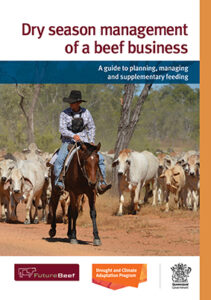Managing for dry years and drought
 The North Australian dry tropics has a highly variable climate. Having a plan for managing the dry years is crucial for every grazing business.
The North Australian dry tropics has a highly variable climate. Having a plan for managing the dry years is crucial for every grazing business.
The higher the rainfall variability for your area the more flexible you need to be with adjusting cattle numbers to manage for seasonal variability.
Rainfall variation
The variability of rainfall is simply the spread of rainfall above or below your average rainfall. Rainfall at Birdsville is highly variable (67%) while rainfall at Clifton is less variable (23%), so Birdsville annual rainfall is 3 times more variable than Clifton. Likewise, the annual rainfall at Boulia (61%) is nearly twice as variable as Mount Surprise (33%).
Objective decision dates
It is important to establish some key trigger points or decision dates to respond early to poor seasons by moving or selling-down cattle to match stocking rates to pasture on hand. Carrying capacity needs to be assessed regularly so that at any time you can match stock numbers to carrying capacity. This is vital in managing your most valuable resource: the perennial, palatable and productive (3P) grasses. A healthy stand of 3P grasses and good ground cover enable a good response to rainfall.
Short term options and benefits
Following are some short-term management options which provide financial rewards as well as prevent animal welfare problems during extended dry conditions.
-
- A highly variable climate means you need to maintain maximum flexibility in adjusting herd size to match feed supply with feed demand.
- The higher your rainfall variability the lower your breeder numbers should be in relation to your total cattle numbers. In highly variable rainfall regions many producers have transitioned entirely from a breeding enterprise to a more flexible and profitable steer turnover operation.
- The higher the rainfall variability the higher the requirement for annual wet season spelling. For example, in the Mount Surprise area it is recommended to spell 20% of your country per year. In the Boulia region, this figure is 40%.
- Establish trigger points to reduce cattle numbers based on your rainfall records. For example, in the Northern Gulf a common trigger point is the end of February. If the wet is poor, adjust numbers. Sell, agist or send cattle to a feedlot. At Easter, if the season is still poor, adjust numbers again for a serious reduction in cattle numbers. At this time, the cattle will still in saleable condition.
- Bare paddocks struggle to grow grass when it rains. Retain some break of season stubble and ground cover in paddocks to maximise pasture growth and minimise runoff.
- Wean calves off lactating cows to reduce their nutrient requirements.
- Sell dry or aged breeders to reduce feed requirements.
- Move cattle before animal welfare issues prevent transportation.
- If you have valuable stud stock devise a long term feeding plan with 2 to 3 years of fodder reserved, depending on your location and herd size. Options include hay, silage, whole cottonseed, grain, molasses and irrigation. Or you might consider purchasing a property in a wetter northern or coastal area.
Long term considerations
During extended dry periods some stock may require transporting to ensure their survival and to free-up feed reserves for the stock remaining behind. It is important when transporting stock in poor condition that they are fit to load as animal welfare is essential for sustainable and profitable cattle production. It is also a legal responsibility.
To determine your rainfall variability, visit Visit CliMate or Rainman to determine your rainfall variability.
Remember, no rain – no grass – no cattle is the only way to manage the dry years.
Written by Bernie English, Senior Extension Officer, Department of Agriculture and Fisheries
The GrazingFutures Project was responsible for reviewing ‘Managing for dry years’ article. GrazingFutures is funded by the Queensland Government’s Drought and Climate Adaptation Program that aims to build drought and business resilience for Queensland livestock producers.
Managing dry years: Tools and books
Australian CliMate will provide an overview of climate variability in your area using historical data drills.
Dry season management of a beef business is an online booklet that guides readers through planning, managing and supplementary feeding.
Fit to load is a publication from Meat & Livestock Australia that helps livestock operators meet the Australian Animal Welfare Standards & Guidelines for the Land Transport of Livestock and decide whether an animal is fit to be loaded for transport and for the entire journey.
Producer case studies
Getting ahead in drought through early weaning and planning →
Additional information